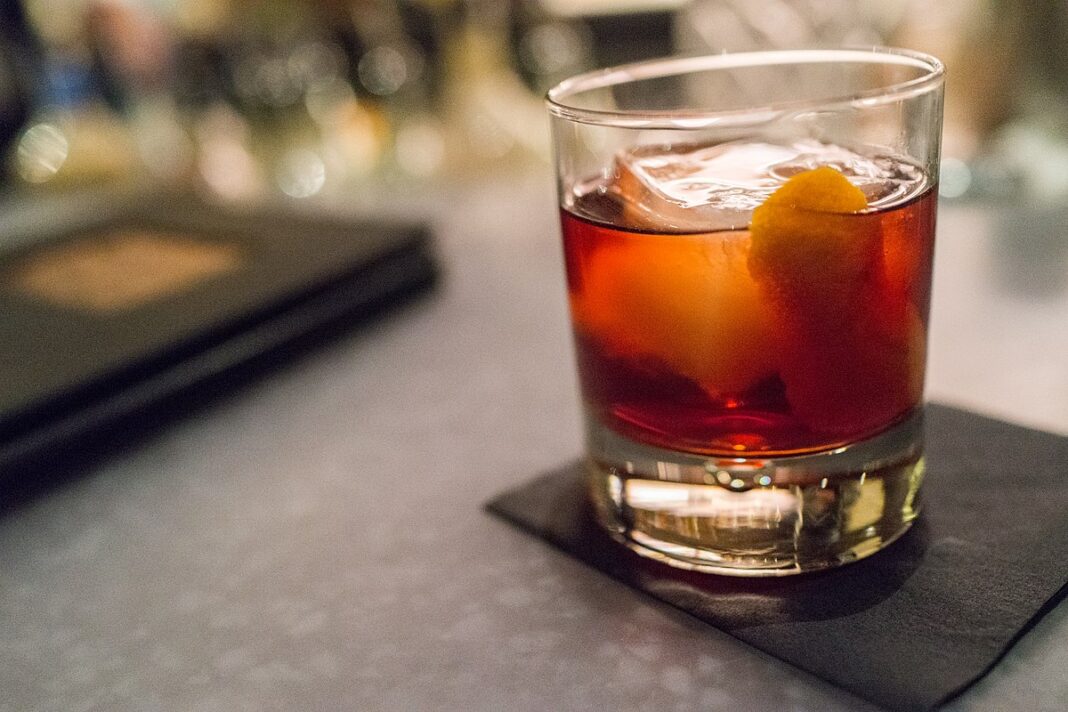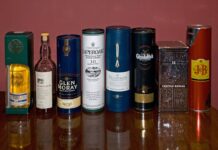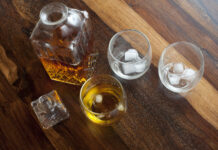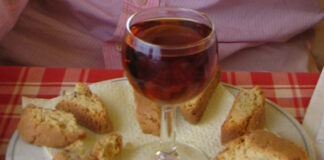Shake It Till You Make It
Super Cool Corn Whiskey Cocktails
You can use corn whiskey and substitute bourbon almost everywhere. Just keep in mind the character of the corn whiskey you choose to use. They generally tend to have more complex flavors. Moreover, unaged corn whiskeys are a bit of a bite. Therefore, it is recommended that you use them in traditionally recognized recipes.
Corn whiskey is not sold like moonshine with added flavors to add up alcohol content. Nevertheless, try any one of these recipes whenever you feel like having a bourbon-inspired corn whiskey cocktail.
- Bees Knees
Ingredients
- 2,0 ounces of Straight Corn Whiskey
- 0.5 ounce of Domaine de Canton
- 0.5 ounce of honey syrup (containing equal parts of water and honey reduced in a saucepan)
- 0.75 ounce of fresh lime juice
Combine all these ingredients in a cocktail shaker. Add ice and shake well before garnishing the drink with candied ginger.
- Boulevardier
Ingredients
- 1.25 ounce of Straight Corn Whiskey
- 1.0 ounce of Campari (Italian liqueur)
- 1.0-ounce of sweet vermouth
- 1 orange twist
Put all of these together in an old-fashioned glass filled with ice. Stir to combine them before garnishing with the orange twist.
- Forbidden Sour
Ingredients
- 1.0 ounce of Straight Corn Whiskey
- 1.0 ounce of pomegranate liqueur
- 0.5 ounce of simple syrup
- 0.5 ounce of lemon juice
Combine all four ingredients in a mixing jar. Add ice and shake until it is properly chilled. Fill an old-fashioned glass with ice and strain the cocktail into the glass before garnishing it with a lemon wedge.
- Golden Derby
Ingredients:
- 1.5 ounces of Straight Corn Whiskey
- 1.5 ounces of intense ginger liqueur
- 2.0 ounces of unsweetened grapefruit juice
Add intense ginger spirit, and grapefruit juice in a cocktail shaker. Rock them well and toss water and ice before adding corn whiskey. Take an old-fashioned glass with ice water to chill before adding corn whiskey. Pour the shaker mix over ice and garnish with a grapefruit wedge.
- Horse’s Neck
Ingredients
- 2.0 ounces Corn Whiskey (preferably aged)
- 1 splash of ginger ale
- 1 lemon peel
Add the corn whiskey to an old-fashioned glass filled with ice. Add ginger ale before garnishing the drink with a lengthy strip of lemon peel.
- Moonshine Sweet Tea
Ingredients
- 1.5 ounce of Straight Corn Whiskey
- 1 cup of black tea
- Sugar according to taste
- Mint twig
One teabag per 1 cup of hot water is recommended. Make tea and chill it in the refrigerator for at least a couple of hours. Place ice cubes in your prized highball or mason jar. Then pour the chilled tea and corn whiskey. Gently mix in sugar according to taste before garnishing it with a twig of mint.
- Smash & Grab
Ingredients
- 2.0 ounces of Straight Corn Whiskey
- 2 orange slices
- 2 mint sprigs
- 0.25 ounce of simple syrup
Muddle mint and orange juice together in a cocktail shaker. Add simple syrup, corn whiskey, and ice together. Shake them to get together. Serve over crushed ice and garnish the drink with mint sprig and an orange slice.
- Strawberry Moonshine
Ingredients
- 2.0 ounce of Straight Corn Whiskey
- 0.5 ounce fresh-squeezed lemon juice
- 1 teaspoon of sugar according to taste
- 2 strawberries (washed, hulled, and chopped)
- Put sugar in a highball or mason jar before adding lemon juice to dissolve it into a mix. Then add strawberries and ice. Pour corn whiskey over, and gently stir.
- White Dog Julep
Ingredients
- 2.5 ounces of Straight Corn Whiskey
- 4 twigs of mint leaves
- 2 sugar cubes
- Mint for garnishing
Begin with a Collins or double old-fashioned glass. Then add mint sprigs and sugar cubes. Gently muddle the ingredients to release the mint oils. Take care not to overdo to tear the leaves. Add corn whiskey and fill the glass with crushed ice. Stir until the glass beads with condensation before garnishing the cocktail with mint.
And when you feel like taking a whole new take, try this one –
Edwin Zee’s Bottom Shelf New York Sour
This cocktail is made with the avant-garde Mellow Corn. It includes a Bottled-in-Bond, Kentucky Straight Corn Whiskey. To carry “Bottled-in-Bond” on the label, The spirit should be from a single distilling year to carry this stamp. This whiskey is aged in a federal storehouse for four years at least. Only then is it bottled at 100 proof.
Neat Corny Whiskey Vibes
Mellow Corn whiskey is also worth having it straight. Although, it may be a little too sweet for those who lean towards the peated Scotch whiskies.
Nevertheless, here are a few bottles that shine in case you prefer your corn whiskey neat.
On a hot day, Heaven Hill’s Mellow Corn Bottled-in-Bond unaged whiskey can be a nice sipping whiskey to try. This corn whiskey has come a long way since it was first released in 1945.
The Mexican Sierra Norte Distillery conducts a whiskey-tasting master class. All corn whiskeys they produce are similar mash bills containing 85 percent corn and 15 percent malted barley. Moreover, the corn that goes in the whiskeys are black, purple, red, yellow, and white. These are all heirloom varieties native to Oaxaca.
Sierra Norte approves that what you put in the whiskey makes the difference. Each of the whiskeys they produce has a differing flavor profile.
- Yellow Corn Whiskey: It comes with a nose comprised of fresh linen, blue iris, and dried chilies.
- Purple Corn Whiskey: This one is with pepper and allspice nose alongside dry nutty, brisket notes, and star anise.
- Red Corn Whiskey: This big mouthful whiskey comes with flavors of baked orange, fruit concentrate, and red bell pepper.
Tenth Ward Distilling makes smoked corn whiskey. This whiskey is made from 80 percent smoked corn and 20 percent malted barley. These grains are sourced locally from the West Virginian Ripon Lodge Farm. This corn whiskey with butter and sweet corn notes mixed with campfires reminds you of mezcal or scotch. It is worth sipping anyway.
Located in Colorado, the Snitching Lady Distillery makes Button’s Blue Corn Whiskey. It comes from 100 percent native blue corn. This corn whiskey displays notes of pecan, toffee, and vanilla along with flavors of butterscotch and caramel. You would love to savor this one for sure.
More Corny Fun To Come
There are several micro-distilleries across the country. They are trying variations on several themes and uncovering many strains of heirloom corn including testing sour vs. sweet mashes. You can very well expect to see plenty of different aging and finishing techniques in the days to come. These distilleries are looking for inspiration by using local cooperages. They intend to bring in used European oak as well.
It would be great to see a movement away from homogeneous corn as distilleries gravitate towards more grain-to-bottle local distilling. This is good for all whiskey enthusiasts and their tastebuds. The Sierra Norte Distillery shows the way. Moreover, modern distillers are nowadays bringing in an overlooked component of American whiskey. So watch out and keep an eye out for corn whiskey at your local liquor shop. You never know what is in store.
Five Bottles Of Corn Whiskeys Worth Seeking Out for Cocktails
Apart from the cult-favorite Mellow Corn here are five more bottles of corn whiskey worth seeking out for your favorite cocktails.
- Balconies Baby Blue: This is the original heirloom corn whiskey from Balcones in Texas. It still holds an exalted esteem among its rivals. This corn whiskey is made from 100 percent Texan blue corn. Alongside a rich buttery texture with flavors of banana bread, grilled corn, and sweet honey, Baby Blue has an approachable price point. It is good to go with your favorite cocktail.
- Southern Revival Straight Whiskey: This whiskey is made by High Wire Distilling Co. in Charleston, South Carolina. It uses 100 percent Jimmy Red heirloom corn. Due to the aging process, the Southern Revival Straight Whiskey also qualifies as bourbon. However, with a dark chocolate and nutty character it sets itself apart from other bourbons. This corn whiskey has a sweet tea finish that will immensely please American whiskey lovers. Especially those looking out for something different without jumping the shark.
- Reservoir Bourbon Whiskey: This corn whiskey also prides itself since it is aged but made from 100 percent locally sourced Virginian corn. It is aged in heavily charred small-format casks. Reservoir Bourbon is an easy-going corn whiskey that comes with notes of cherry, complex nutty coffee, toasted cornbread, and vanilla. It warrants a generous pour and describes itself as the most traditional house expression.
- Abasolo El Whisky de Mexico: This heirloom variety of Mexican Cacahuazintle white dent corn originated in Toluca. Abasolo corn whiskey is prized by bartenders for its complexity and richness. The corn that goes into production undergoes the 4,000-year-old nixtamalization technique. It involves cooking the corn kernels in an alkaline lime solution before drying and milling. This aged corn whiskey is produced in Jilotepec, a hilly region that is an hour from Mexico City. It is far lighter, more floral, and less oak-forward whereby the character of the maize does not punch through the spirit.
- Single Barrel Native Oaxacan Black Corn: This corn whiskey from Sierra Norte hails from Oaxaca in Mexico. They produce five types of whiskeys. Each one uses a different kind of local corn including black, yellow, purple, red, and white. The black variety is however aged in a single European oak cask. It imparts spicy tannins and has a robust and earthy flavor profile compared to other expressions from the producer.
Corn, or more accurately maize, comes forth to define American whiskey. It is the dominant grain in corn whiskey mash bills, including bourbon by regulation. A few expressions of bourbon are also made with more than 80 percent maize corn. Moreover, corn whiskey producers continuously strive for new ways to differentiate within the crowded craft whiskey market. Some oddball examples are offering a glimpse into the state of modern spirits. However, the process, packaging, and marketing are the primary factors setting one bottle apart from another. Moreover, the producer’s willingness to let the ingredients shine in the final product is more important than ever.
Craft Whiskey Is Reviving Heirloom Corn
No party the world over is ever complete without whiskey. Corn whiskey of course! The easy-drinking bottle of Mellow Corn from Heaven Hill Distillery was first produced in 1945. It had become a cult bartender favorite about 10 years before that. The lurid yellow packaging however made it an ironic shot of choice in dive bars overnight.
Corn whiskey then received craft treatment as early as 2003. Hudson Whiskey, the first legal distillery since Prohibition in New York released ‘Baby Bourbon.’ It was made with 100 percent local corn before maturing the spirit in small-format barrels. This whiskey was an instant hit.
Multinational William Grant & Sons took over Baby Bourbon in 2017. It was rechristened as ‘Bright Lights,’ and the mash bill then dropped to 95 percent corn. It would be stretching to still call it ‘craft.’ Nonetheless, it paved the way for several craft whiskeys to come into the market.
Texan Balcones released its Baby Blue in 2008. This distillery took the logical next step by turning to heirloom grains like roasted blue corn. It became a milestone bottle for the corn whiskey movement. The use of heirloom corn varieties for the production of whiskey generally took center stage.
Several others followed suit. New Southern Revival Straight Whiskey, from South Carolina emerged. This whiskey is made with 100 percent Jimmy Red corn by High Wire Distilling Company. This variety of heirloom corn is historically grown on James Island. It is known to be a favorite of South Carolina moonshiners. Thanks to Sean Brock, a champion of threatened Southern heirloom grains, the cultivation of Jimmy Red corn was nearly abolished before being revived in the late 2000s by a coalition of farmers.
Jimmy Red corn has so many flavorful layers. It has plenty of starch which tends to translate into a soft graham texture and flavor. This heirloom corn also contains cinnamic acid. It translates into baking spice flavors in corn whiskey. Jimmy Red is now grown in partnership with Clemson University and largely used by High Wire. The corn lends a signature profile to the whiskey that they describe as minerally, nutty, and sweet along with an extremely high oil content providing an awful creamy mouthfeel.
Virginian Reservoir Distillery in Richmond shares a similar approach. They let the grains speak for themselves. Each of the corn whiskeys they make is made with 100 percent of the base grain. They are uncut and unadulterated. They choose to make their bourbon from 100 percent corn. This allows whiskey enthusiasts an opportunity to discover what pure grains have to offer.
Your Shot Of Whiskey Is Going A Long Way
Corn whiskey is a fledgling category even outside of the United States. Mexico has Abasolo and Sierra Norte; two popular brands dedicated to corn whiskey. It is perhaps an unsurprising fact. Corn was first largely cultivated by Indigenous people in Mexico about 9,000 years back.
Australia has its own booming craft whiskey scenario. Corn whiskey inevitably is part of the growing grain-to-glass trend. The Whipper Snapper Distillery in Western Australia uses locally grown corn for its Upshot 80 percent corn whiskey. This spirit is matured in virgin white oak. Moreover, you have limited-edition bottles aged in virgin European oak and used Pedro Ximénez sherry casks as well.
Ben Bowles on the other side of Australia in Melbourne occasionally releases limited bottlings of aged moonshine. Nonetheless, corn does not carry any enormous amount of grain character through maturation. But aging enables corn whiskey to retain sweetness. Moreover, the effort is coupled with the flavors of the oak. Aged corn whiskey is light and mellow while still being rich. This producer loves working with 100 percent corn whiskeys simply because they throw so much alarm alongside sweetness into the mix. So much so that you can convince rum drinkers to move across to whiskey.
Corn Whiskey Vs. Bourbon
The main difference between bourbon and corn whiskey is the percentage of corn that goes in the mash bill. Aging the spirit is yet another factor.
Bourbon must undertake a minimum of 51 percent corn mash. The remaining percentage in the mash can be any other cereal grains like barley, rye, or wheat. Corn whiskeys differ from bourbon as they have corn mash content exceeding 80 percent. Moreover, they may or not undergo the aging process.
Bourbon is whiskey for sure. Additionally, bourbon is a firm member of the whiskey family. Nevertheless. it does not always go both ways. Especially when it comes to high-corn bourbon. There are quite many similar-sounding but very distinct corn whiskey types as well.
Bourbon, beyond doubt, is the ‘cultural elite’ of American spirits. It is exclusively defined by its nature and often commands high prices. The rigid ingredient and process requirements stubbornly define bourbon. Even if the same recipe gets replicated outside the United States. Although, it may not be known by the same name. Bourbon is strictly an American creation. According to an Act of Congress designed as ‘The Official Spirit of America’ in the year 1964.
The bourbon-producing industry has plans to keep that ‘imperceptible’ mystique. It is made easier by a string of non-negotiable rules firmly attached to the production technique including that bourbon must contain at least 51 percent corn. This is the first element to narrow down the playing field between bourbons and standard whiskeys. Then there are separate categories of unaged ‘corn whiskey’ and ‘high corn bourbons.’
High-corn bourbons have an aging element of two years at least. Both bourbons and corn whiskeys contain corn in their mash bills. It is the distiller’s unique combination and percentage of corn, rye, malted barley, and wheat that makes the difference. The required percentage of corn rises from 51 percent to 80 percent for ‘high corn’ bourbon. This equates to the same amount in a corn whiskey. Although this equal playing field establishes that the two are interchangeable, it does not necessarily work that way due to the governing regulations.
Strictly defining designation policies govern how bourbon, including high corn versions, is required to be produced. Some of these applications govern corn whiskeys as well. Others deliberately and specifically delineate the two. Bourbon must be made in America without any exceptions. But corn whiskeys can come from anywhere in the world, as long as they meet standards like the 80 percent corn content. However, the distinctions diverge from there. It now comes down to the barrels and how long the spirits are required to remain inside them.
Bourbons have obligatory storage requirements for barrel materials and aging times. These generally differ for corn whiskeys. Bourbon is required to be stored in brand-new charred oak barrels. Moreover, the spirit must remain there for at least two years. It is quite the opposite as far as the production of corn whiskey is concerned.
Follow Your Spirit Through Corn
Corn whiskey restrictions are designed to protect bourbon territory. Standard corn whiskeys have no aging requirements in comparison to high corn bourbons. The only exception is when the bottle is labeled as a ‘straight corn whiskey.’ In this case, the spirit undergoes the same two-year aging requirement as bourbon. Moreover, the Alcohol and Tobacco Tax & Trade Bureau (TTB) crucially defines that oak-based storage of corn whiskey must take place in used or uncharred vessels instead of new ones. These guidelines specifically prevent corn whiskey from being classified as a type of bourbon.
You can also forget about externally adding that distinctive charred-wood bourbon taste to corn whiskey. through oak chips; The TTB states a no-go to adding oak chips during the maturation process. Corn whiskeys therefore cannot be blended with any other spirit that has stayed in contact with charred wood. Lastly, all bourbons by law, including high corn versions, cannot contain any added colors or flavors. Nothing but water when needed can be utilized to reach the maximum proof restriction.
A gift from Mother Nature alone can impact bourbon differently than other whiskeys, including high-corn varieties. It is primarily water, according to Kentucky Tourism. Almost 95 percent of all bourbon comes from Kentucky. The region benefits from limestone reserves through which the state waters flow. They naturally filter out any harsh-tasting undesirable elements like iron and minerals.









